Abstract
Serological and epidemiological studies suggest that Bartonella henselae is the etiological agent of cat scratch disease. We designed a study to detect B. henselae in archival biopsies by polymerase chain reaction amplification of the 16S rRNA gene followed by Southern blot hybridization. Forty-two histologically defined cat scratch disease biopsies and eighteen controls were selected for blinded analysis. After testing, charts were reviewed for clinical, immunological, and microbial evidence of infection. Results were correlated with duration of illness and antimicrobial therapy. B. henselae DNA was identified in 27 of 42 (64%) histologically defined patients and 23 of 34 (68%) patients defined both clinically and histologically. There were no false positives (0 of 18). A small subset (n = 14) had cat scratch disease serological tests performed. B. henselae was identified in 8 of 10 serologically positive patients. Polymerase chain reaction detected 50% of our DNA-positive cases (most of these early in the clinical course). Southern blotting of amplicons both doubled sensitivity (detecting patients > 4 weeks into illness) and confirmed B. henselae as the causative species. Our study strongly associates B. henselae with cat scratch disease, suggesting that it may be the most likely etiological agent in the majority of patients with cat scratch disease.
Full text
PDF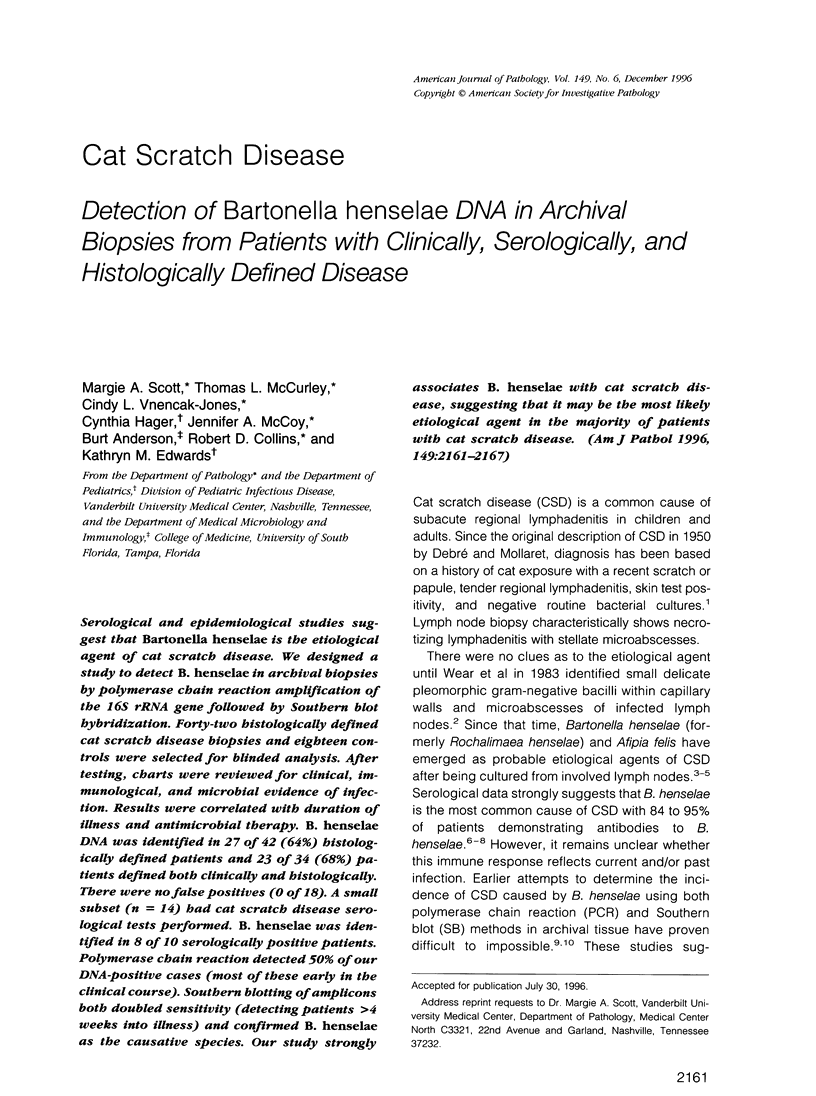
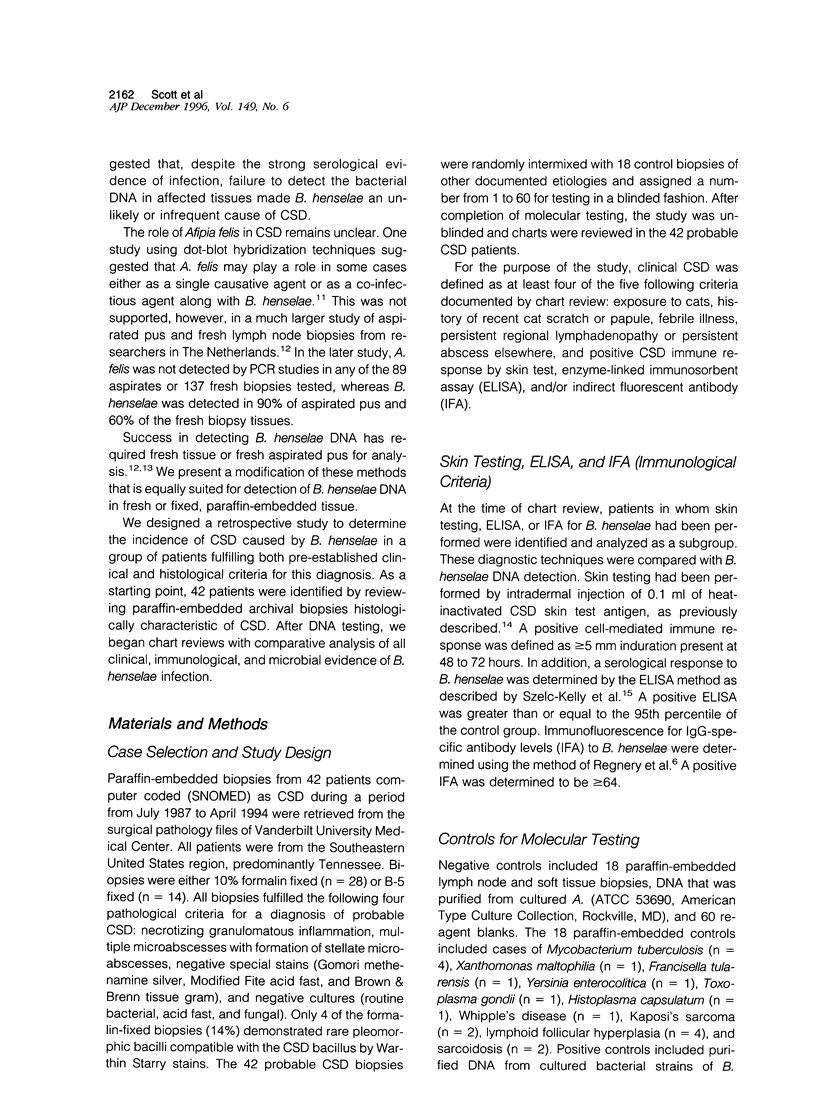
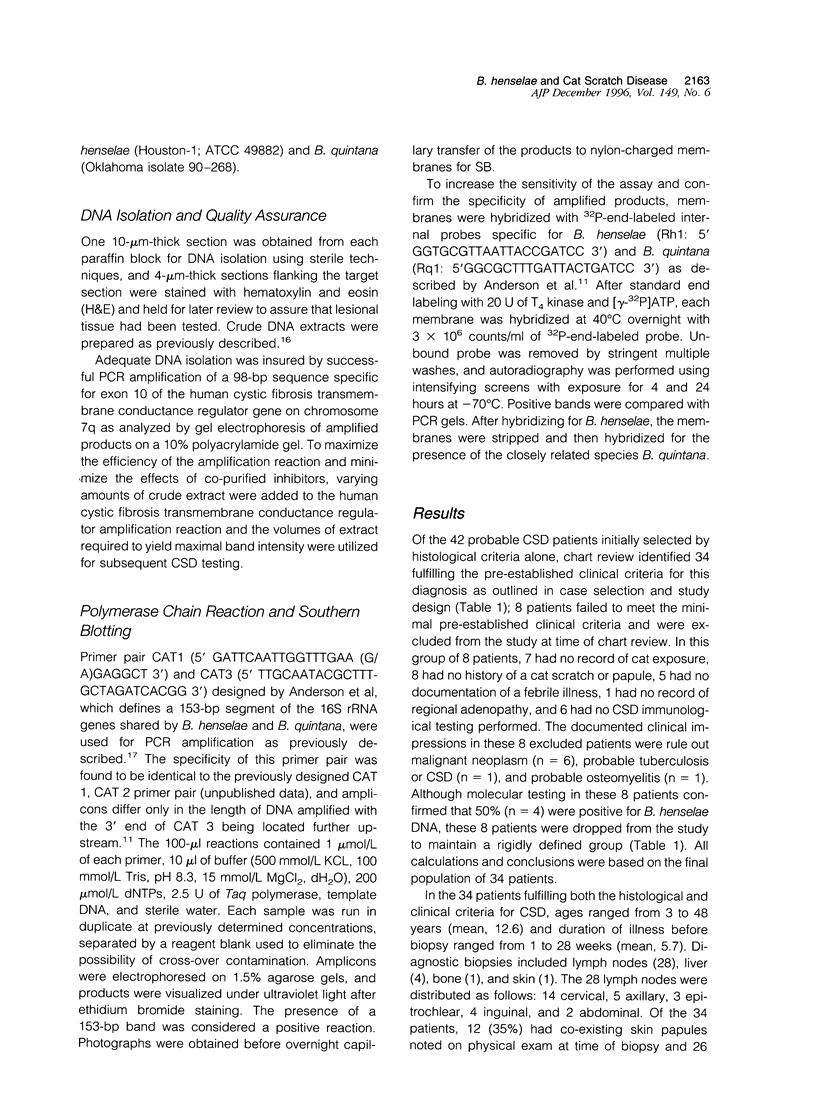
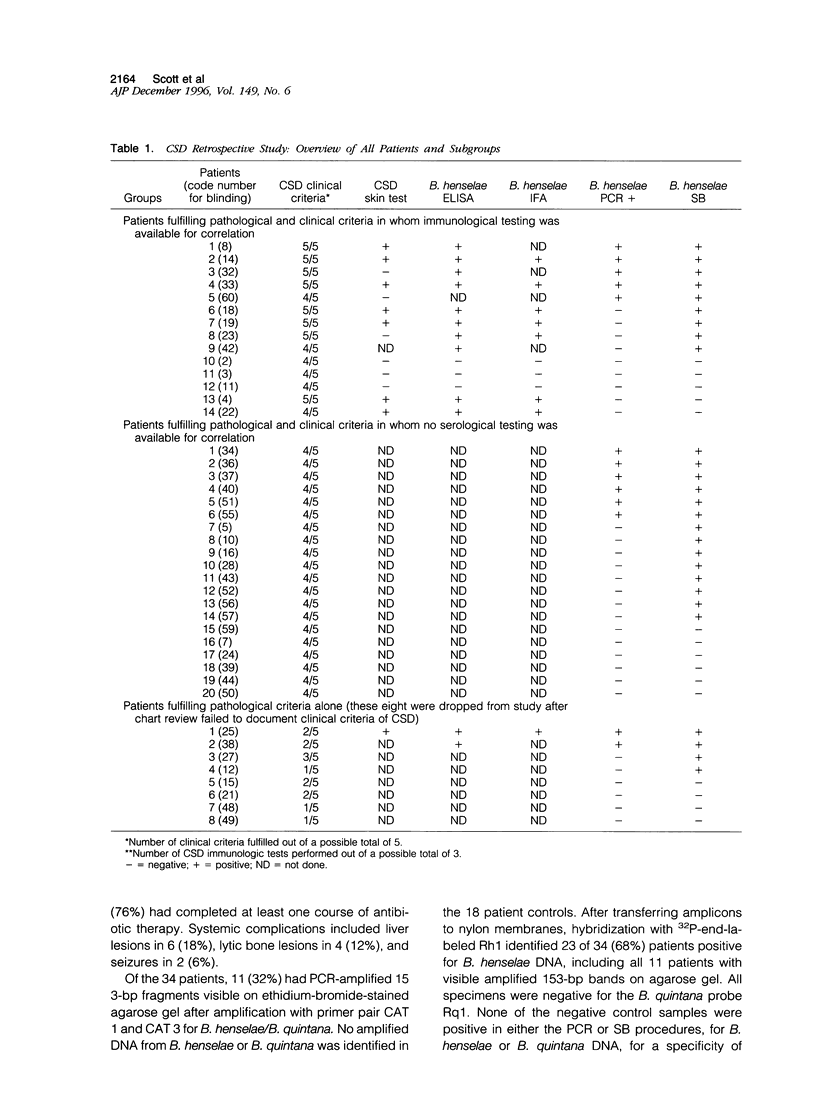
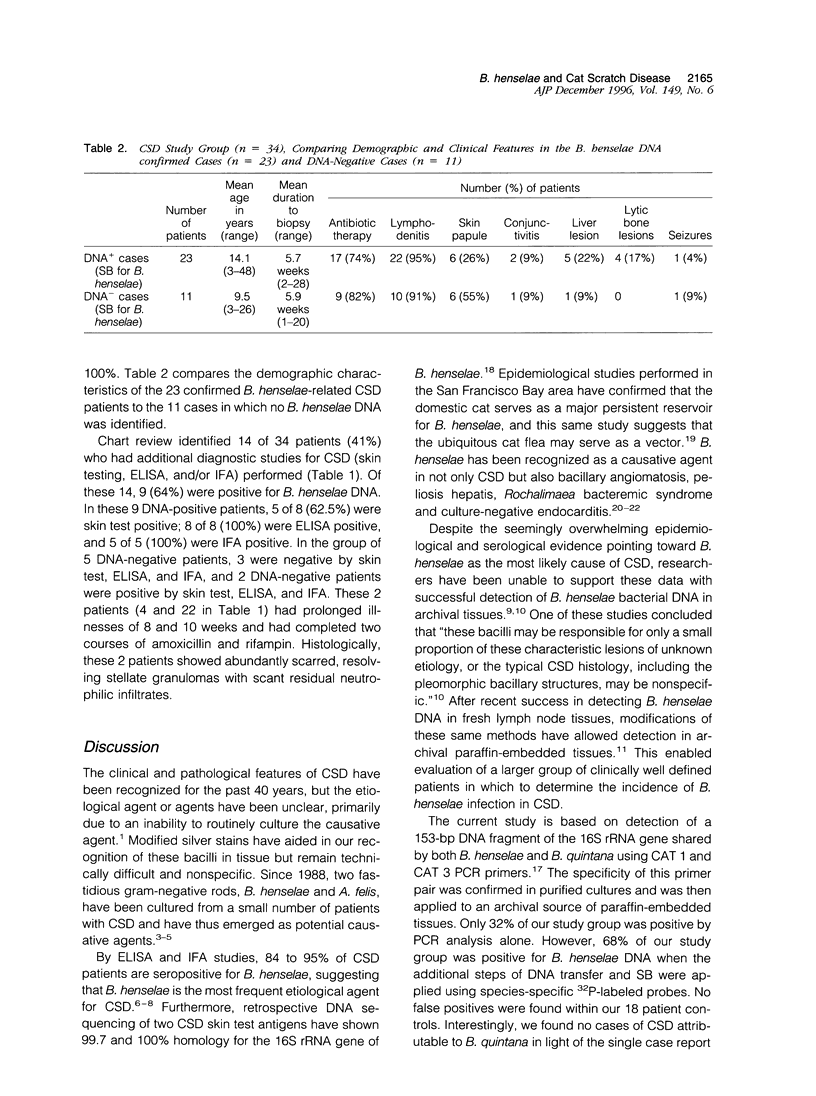
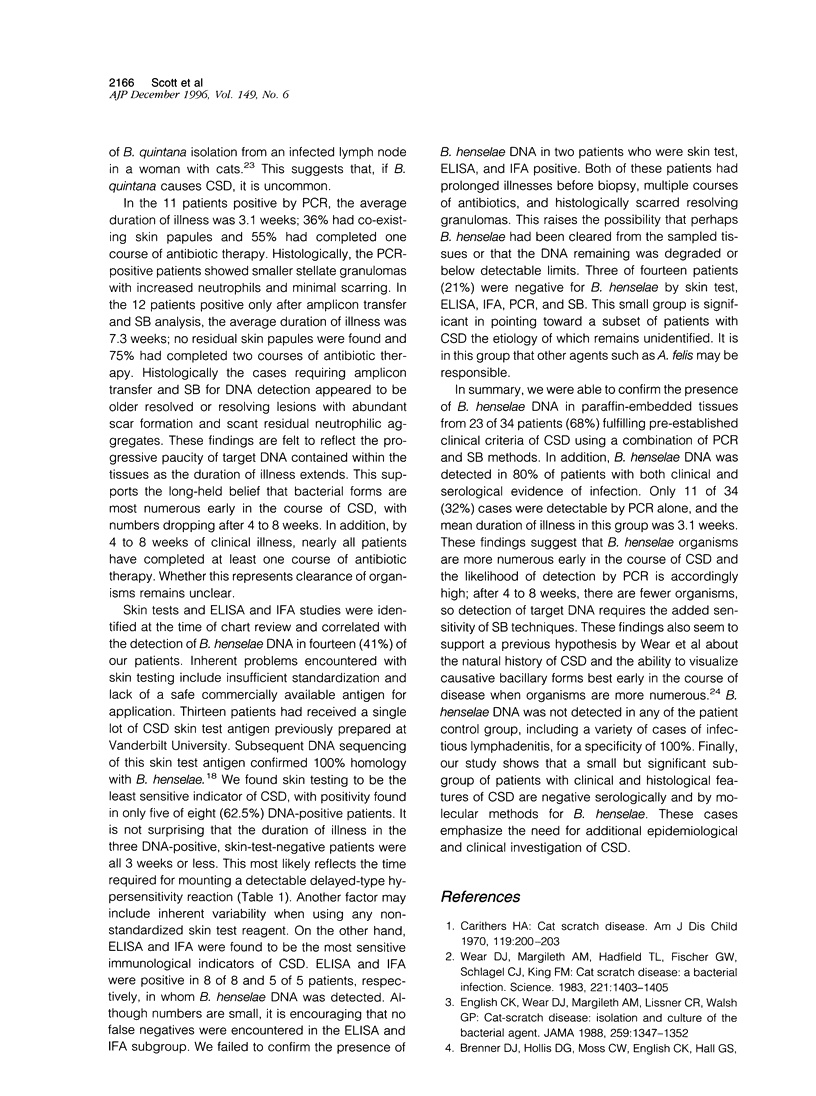
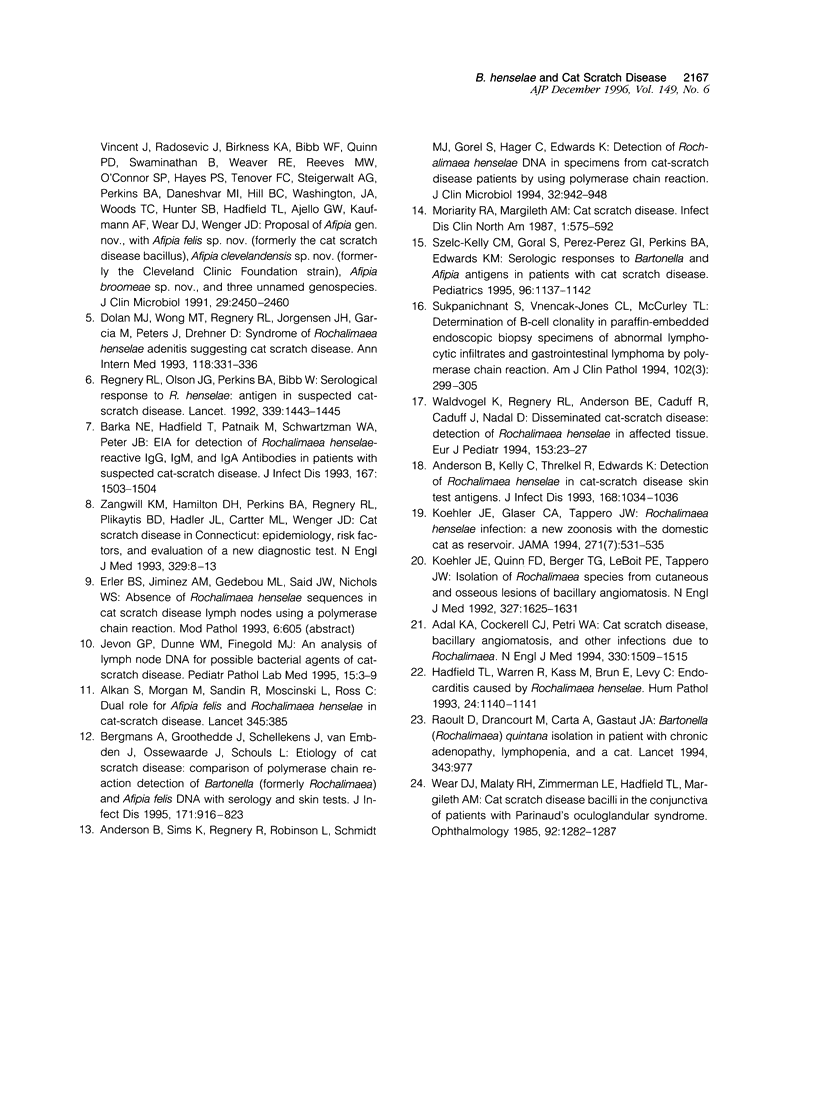
Selected References
These references are in PubMed. This may not be the complete list of references from this article.
- Adal K. A., Cockerell C. J., Petri W. A., Jr Cat scratch disease, bacillary angiomatosis, and other infections due to Rochalimaea. N Engl J Med. 1994 May 26;330(21):1509–1515. doi: 10.1056/NEJM199405263302108. [DOI] [PubMed] [Google Scholar]
- Anderson B., Kelly C., Threlkel R., Edwards K. Detection of Rochalimaea henselae in cat-scratch disease skin test antigens. J Infect Dis. 1993 Oct;168(4):1034–1036. doi: 10.1093/infdis/168.4.1034. [DOI] [PubMed] [Google Scholar]
- Anderson B., Sims K., Regnery R., Robinson L., Schmidt M. J., Goral S., Hager C., Edwards K. Detection of Rochalimaea henselae DNA in specimens from cat scratch disease patients by PCR. J Clin Microbiol. 1994 Apr;32(4):942–948. doi: 10.1128/jcm.32.4.942-948.1994. [DOI] [PMC free article] [PubMed] [Google Scholar]
- Barka N. E., Hadfield T., Patnaik M., Schwartzman W. A., Peter J. B. EIA for detection of Rochalimaea henselae-reactive IgG, IgM, and IgA antibodies in patients with suspected cat-scratch disease. J Infect Dis. 1993 Jun;167(6):1503–1504. doi: 10.1093/infdis/167.6.1503. [DOI] [PubMed] [Google Scholar]
- Bergmans A. M., Groothedde J. W., Schellekens J. F., van Embden J. D., Ossewaarde J. M., Schouls L. M. Etiology of cat scratch disease: comparison of polymerase chain reaction detection of Bartonella (formerly Rochalimaea) and Afipia felis DNA with serology and skin tests. J Infect Dis. 1995 Apr;171(4):916–923. doi: 10.1093/infdis/171.4.916. [DOI] [PubMed] [Google Scholar]
- Carithers H. A. Cat-scratch disease; notes on its history. Am J Dis Child. 1970 Mar;119(3):200–203. doi: 10.1001/archpedi.1970.02100050202002. [DOI] [PubMed] [Google Scholar]
- Dolan M. J., Wong M. T., Regnery R. L., Jorgensen J. H., Garcia M., Peters J., Drehner D. Syndrome of Rochalimaea henselae adenitis suggesting cat scratch disease. Ann Intern Med. 1993 Mar 1;118(5):331–336. doi: 10.7326/0003-4819-118-5-199303010-00002. [DOI] [PubMed] [Google Scholar]
- English C. K., Wear D. J., Margileth A. M., Lissner C. R., Walsh G. P. Cat-scratch disease. Isolation and culture of the bacterial agent. JAMA. 1988 Mar 4;259(9):1347–1352. doi: 10.1001/jama.259.9.1347. [DOI] [PubMed] [Google Scholar]
- Hadfield T. L., Warren R., Kass M., Brun E., Levy C. Endocarditis caused by Rochalimaea henselae. Hum Pathol. 1993 Oct;24(10):1140–1141. doi: 10.1016/0046-8177(93)90196-n. [DOI] [PubMed] [Google Scholar]
- Jevon G. P., Dunne W. M., Finegold M. J. An analysis of lymph node DNA for possible bacterial agents of cat-scratch disease. Pediatr Pathol Lab Med. 1995 Jan-Feb;15(1):3–9. doi: 10.3109/15513819509026935. [DOI] [PubMed] [Google Scholar]
- Koehler J. E., Glaser C. A., Tappero J. W. Rochalimaea henselae infection. A new zoonosis with the domestic cat as reservoir. JAMA. 1994 Feb 16;271(7):531–535. doi: 10.1001/jama.271.7.531. [DOI] [PubMed] [Google Scholar]
- Koehler J. E., Quinn F. D., Berger T. G., LeBoit P. E., Tappero J. W. Isolation of Rochalimaea species from cutaneous and osseous lesions of bacillary angiomatosis. N Engl J Med. 1992 Dec 3;327(23):1625–1631. doi: 10.1056/NEJM199212033272303. [DOI] [PubMed] [Google Scholar]
- Moriarty R. A., Margileth A. M. Cat scratch disease. Infect Dis Clin North Am. 1987 Sep;1(3):575–590. [PubMed] [Google Scholar]
- Raoult D., Drancourt M., Carta A., Gastaut J. A. Bartonella (Rochalimaea) quintana isolation in patient with chronic adenopathy, lymphopenia, and a cat. Lancet. 1994 Apr 16;343(8903):977–977. doi: 10.1016/s0140-6736(94)90102-3. [DOI] [PubMed] [Google Scholar]
- Regnery R. L., Olson J. G., Perkins B. A., Bibb W. Serological response to "Rochalimaea henselae" antigen in suspected cat-scratch disease. Lancet. 1992 Jun 13;339(8807):1443–1445. doi: 10.1016/0140-6736(92)92032-b. [DOI] [PubMed] [Google Scholar]
- Sukpanichnant S., Vnencak-Jones C. L., McCurley T. L. Determination of B-cell clonality in paraffin-embedded endoscopic biopsy specimens of abnormal lymphocytic infiltrates and gastrointestinal lymphoma by polymerase chain reaction. Am J Clin Pathol. 1994 Sep;102(3):299–305. doi: 10.1093/ajcp/102.3.299. [DOI] [PubMed] [Google Scholar]
- Szelc-Kelly C. M., Goral S., Perez-Perez G. I., Perkins B. A., Regnery R. L., Edwards K. M. Serologic responses to Bartonella and Afipia antigens in patients with cat scratch disease. Pediatrics. 1995 Dec;96(6):1137–1142. [PubMed] [Google Scholar]
- Waldvogel K., Regnery R. L., Anderson B. E., Caduff R., Caduff J., Nadal D. Disseminated cat-scratch disease: detection of Rochalimaea henselae in affected tissue. Eur J Pediatr. 1994 Jan;153(1):23–27. [PubMed] [Google Scholar]
- Wear D. J., Malaty R. H., Zimmerman L. E., Hadfield T. L., Margileth A. M. Cat scratch disease bacilli in the conjunctiva of patients with Parinaud's oculoglandular syndrome. Ophthalmology. 1985 Sep;92(9):1282–1287. doi: 10.1016/s0161-6420(85)33870-8. [DOI] [PubMed] [Google Scholar]
- Wear D. J., Margileth A. M., Hadfield T. L., Fischer G. W., Schlagel C. J., King F. M. Cat scratch disease: a bacterial infection. Science. 1983 Sep 30;221(4618):1403–1405. doi: 10.1126/science.6612349. [DOI] [PubMed] [Google Scholar]
- Zangwill K. M., Hamilton D. H., Perkins B. A., Regnery R. L., Plikaytis B. D., Hadler J. L., Cartter M. L., Wenger J. D. Cat scratch disease in Connecticut. Epidemiology, risk factors, and evaluation of a new diagnostic test. N Engl J Med. 1993 Jul 1;329(1):8–13. doi: 10.1056/NEJM199307013290102. [DOI] [PubMed] [Google Scholar]


